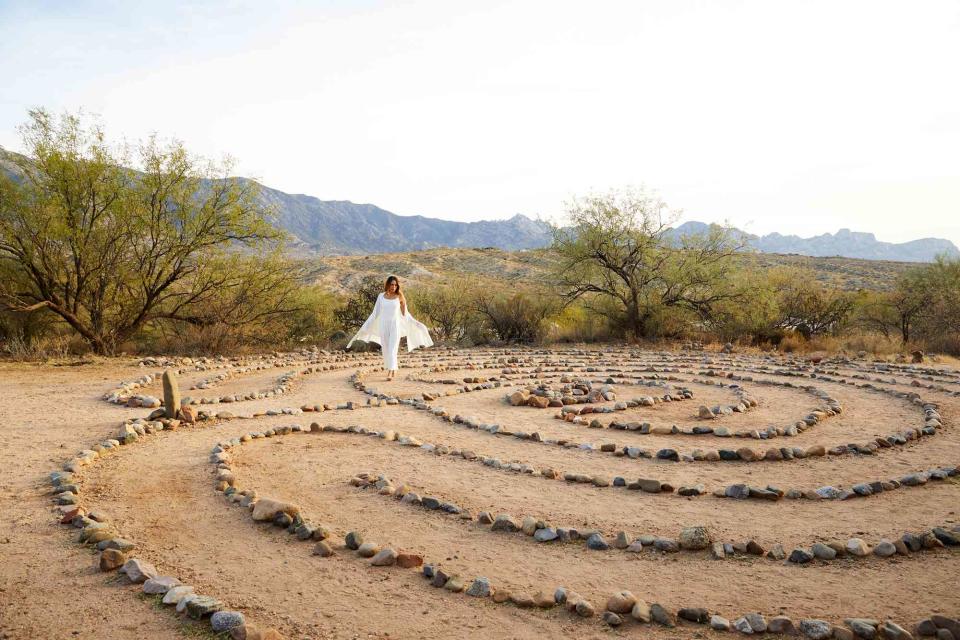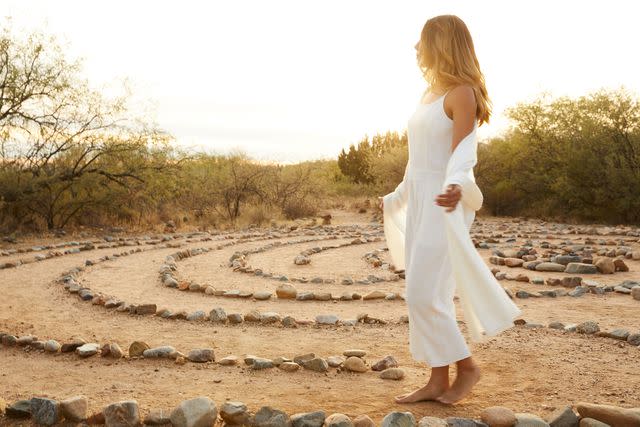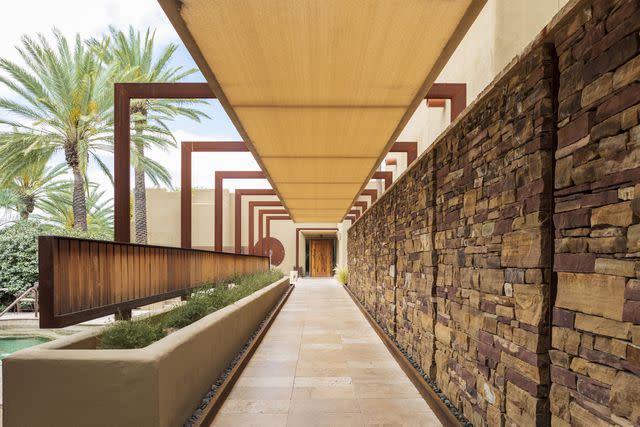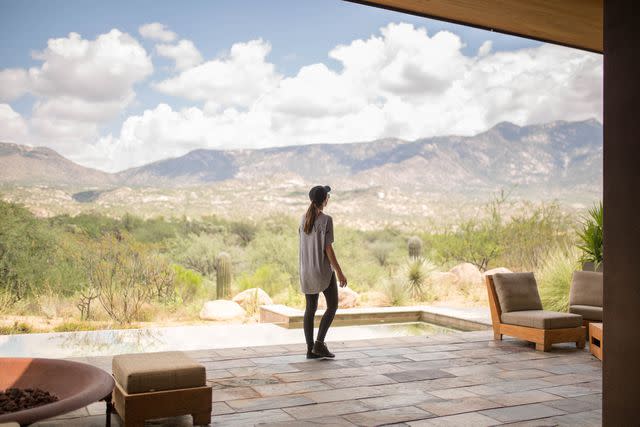I Went to a Wellness Resort in Arizona on a Solo Postpartum Trip — Here's How the Meditation Labyrinth Actually Cleared My Mind
One travel writer takes a closer look at how meditation labyrinths ease wellness-seekers' minds — and finds it really works for her.

Courtesy of Miraval Arizona Resort & Spa
When I arrived at Miraval Arizona Resort & Spa, in the Sonoran Desert outside Tucson, I was full of emotions. A year earlier, I had given birth to my second son. And just a couple weeks after his first birthday, I was away from him for the first time. I had also decided to ween him from breastfeeding while I was away, making this trip even more difficult.
But I needed time to myself after an intense year of baby-caring that always had me putting myself and my needs second (or third, fourth, or let's be real, dead last). I was treating myself to a wellness retreat at one of the world’s best resorts for it, in the hopes of easing my anxiety and completing my postpartum year on a high note. I had signed up for things like yoga classes, a floating meditation, a reflexology session, and several massages and decadent scrubs. I brought a book that I hadn’t cracked open since I was pregnant, and I was eager to get a few good nights of sleep in my calming room with a plush bed and no crying baby.
At the end of my second day, after a particularly luxurious spa treatment, I found myself in a bit of a daze, wandering the property as the sun began to lower behind the mountains. My breasts were sore, and I needed to pump to relieve myself. Still, I noticed I was on a part of the property I hadn't been to before, away from the main restaurant and spa where I had been spending most of my time. I saw the edge of the desert, with its iconic saguaro cactuses poking up, and the multicolored mountains looming in the background. In front of me was a massive, circular labyrinth marked off with rocks. I had never seen one so large, or so intricate.

Courtesy of Miraval Arizona Resort & Spa
No one else was around. There was a small sign suggesting visitors carry a small stone representing a burden they’d like to release — and then leave it in the center of the labyrinth. I grabbed a rock and entered the path, which immediately veered off in an unexpected direction. (Metaphoric, no?) I followed along in a dreamlike state, snaking around the path yet never reaching the center when I thought I would. The slow, methodical, and intentional walk took over my mind. It was strangely soothing and hypnotic.
It turns out what I felt wasn’t distinct. Walking a labyrinth — several pathways that intertwine in a circular pattern around a central point — is a practice that goes back thousands of years. Labyrinth walking has been used by many to foster spiritual focus, contemplation, and reflection. It's often used as a form of active meditation. There have been labyrinth patterns found on ancient Greek petroglyphs, they are discussed in Greek mythology, and there are church labyrinths dating back to medieval times.
Today, labyrinths can be found in places like hospitals and mental health care facilities, prisons, places of religious worship, parks, and yes, wellness resorts. (Here is a database of the world’s labyrinths, and here is a way to make one in your own home, plus tips for walking one.) Patterns and sizes of labyrinths vary greatly, and they can be made of any material, although typically they’re created from something found in nature like rocks, sand, or wood, although they can also be painted or drawn on the ground. It’s important to note that a labyrinth is not the same as a maze. A maze has dead ends and wrong turns. It is meant to confuse you, and it is a problem to be solved. To the contrary, a labyrinth has a singular way in and a singular way out — you can’t get lost.

Courtesy of Miraval Arizona Resort & Spa
Modern studies have revealed that walking a labyrinth can contribute to recovery by promoting spiritual self-care and reflection, and it can even have physical health benefits.
Reverend Stephen Yeo, a certified labyrinth facilitator and certified spiritual care practitioner in Ontario, Canada, helped lead a study with Lawson Research Health Institute and noted, “Research has demonstrated that labyrinth-walking can result in increased focus and calm, along with a reduction in blood pressure and stress. Additionally, labyrinth-walking is narrative-driven and highly constructivist in nature, which promotes the opportunity for one to critically reflect on his or her unfolding story.”
There is no specific way you must walk a labyrinth, although usually to receive some benefit, you should enter and walk the labyrinth slowly and intentionally, clearing your mind as best you can, focusing on the task at hand.
Walking a labyrinth is as much about the journey as it is about the predetermined central endpoint, and since you can’t get lost, that potential stress is eliminated. Still, as you seemingly near the center, and then suddenly find yourself being directed farther away yet again, you can think about your life’s goals and expectations. The winding paths of labyrinths can aid in readjusting those goals and expectations, and help us understand how unpredictable digressions can arise in life.

Courtesy of Miraval Arizona Resort & Spa
When I finally did reach the seemingly elusive center of the convoluted labyrinth at Miraval Arizona, I stood at the center of the spiral, staring out into the vast desert dotted with stoic cactuses. I put down the rock I had been clutching, pushing it into the dirt at my feet, silently releasing the pressure to be the perfect mother, the ideal wife, the always-attentive friend, the successful writer. I had made it, if only to this small spot where it was impossible to get lost. But still, I felt a sense of accomplishment. I won’t say I suddenly felt like I could tackle raising my children with ease, but I did feel slightly less overwhelmed with life — for a few moments anyway.
My postpartum path hasn't been the straight line I imagined when I gave birth (even the second time), and motherhood is anything but predictable. Like so many things in life, motherhood zigzags and shoots off to surprising and unknown places. Sometimes those twists and turns help me progress, but other times I have to readjust and try again. And that’s ok.
For more Travel & Leisure news, make sure to sign up for our newsletter!
Read the original article on Travel & Leisure.


